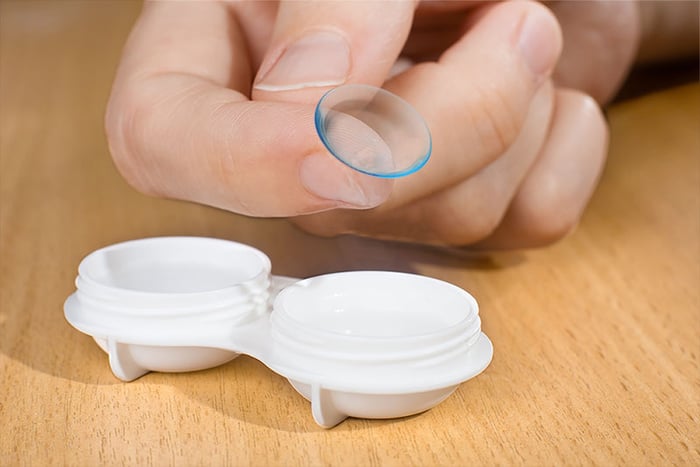There are many reasons you may desire to wear contact lenses. You may have bad vision and prefer contact lenses for either cosmetic or medical vision correction reasons. Or maybe you’re an athlete who’s tired of annoying glasses during workouts.
While for some, soft contact lenses solve their vision difficulties, for others—specifically those with irregular corneas or hard-to-fit-eyes—normal soft contact lenses are just not feasible. These special cases require special contact lenses. If this sounds like you, why don’t you ask your optometrist about scleral contact lenses for your unique vision needs?
What are scleral contact lenses?
Scleral contacts are large-diameter gas permeable contact lenses specially designed to vault over the entire corneal surface and rest on the "white" of the eye (the sclera). In doing so, scleral lenses functionally replace the irregular cornea with a perfectly smooth optical surface to correct vision problems caused by keratoconus and other corneal irregularities.2

There are many interesting facts about these amazing scleral contact lenses that most folks with irregular corneas or hard-to-fit-eyes are unaware of. Here are a few of them:
1. Scleral contact lenses date back to the early 1880s.
Working from drawings by Leonardo da Vinci and British astronomer Sir John Herschel, these lenses were invented simultaneously by physicians in Germany and France.1 They were built to rest on the conjunctiva of the eye above the sclera (again, the white of the eye) and were not only the first scleral contact lenses but the first contact lenses—period!
In 2008, a new digital process for manufacturing custom contoured scleral lenses was developed, and the lenses have since seen a resurgence from doctors wanting to fit patients with irregular corneas or other eye conditions.4
2. Scleral contacts, although very large, are actually very comfortable.
Scleral contact lenses are very large. In fact, they are noticeably larger than rigid standard gas permeable (GP) contacts and have a diameter equal to or greater than that of soft lenses.2
Your first impression could potentially be, "I am not putting those huge things in my eyes!"
But the honest truth is that sclerals are very comfortable. The scleral lenses rest on the sclera, which is not as sensitive as the cornea. Also, the large design stays tucked beneath the eyelids, so there's very little irritating movement. This makes scleral contact lenses surprisingly comfortable.
3. Scleral contact lenses provide consistent vision and improved stability.
Another great advantage to wearing scleral contact lenses is stability. They're very stable on the eye, offering consistent, stable optics.3 Also, scleral contact lenses provide a tear film between the cornea and the back surface of the lens. This tear film—the fluid between the eye and lens—keeps the cornea consistently moist, providing enhanced comfort and consistent vision.
4. Scleral contacts are ideal for irregular corneas, hard-to-fit eyes, and dry eyes.
While anyone interested in wearing scleral contact lenses may do so if they want, scleral GP lenses are particularly recommended for the following eye conditions:
Irregular corneas: An irregular shaped cornea – this includes eye conditions such as keratoconus – usually cannot be fully corrected with glasses or soft lenses. Compared to sclerals, soft lenses are really not ideal for irregular cornea patients because the lenses drape over the cornea irregularity. Plus, vision of soft lenses can be disrupted when the lenses rotate, while the vision provided by rigid scleral lenses is not affected by lens rotation. Scleral contact lenses are a great lens for irregular corneas.
Hard-to-fit-eyes: Sometimes eyes cannot be fitted with normal GP lenses because of the shape of the eye. The smaller GP lenses may also tend to pop out during athletic activities. Scleral contact lenses can provide a more comfortable and secure fit.
Dry eyes: Scleral contact lenses do not dehydrate as soft lenses do. The large space between the cornea and the back surface of the scleral lens acts as a tear reservoir, providing a more comfortable experience and welcome relief for dry eyes.
Sclerals are pretty amazing lenses! Originally designed by da Vinci, and renowned for their comfort and stable, consistent vision, these lenses are a great option for irregular corneas and many other eyes conditions.
Don’t you think it’s time to ask your optometrist about sclerals? You won't be disappointed.
References:
1. Bezalel Schendowich, OD, FIACLE, MMABNKcF. What Are Scleral Contact Lenses? https://www.nkcf.org/keratoconus-contact-lenses/scleral-contact-lenses/
2. Jason Jedlicka, OD, FAAO. Scleral Contact Lenses. http://www.allaboutvision.com/contacts/scleral-lenses.htm
3. Scleral Contact Lenses. http://www.contactlenses.org/scleral.htm
4. Scleral Lens. https://en.wikipedia.org/wiki/Scleral_lens


